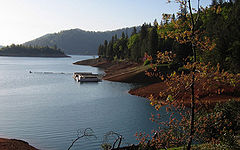Shasta Lake is a reservoir created by the building of Shasta Dam on the Sacramento River, Pit River, McCloud River and several smaller tributaries. Shasta Lake is the largest reservoir in California, and third largest lake, after Lake Tahoe and the Salton Sea. It has a capacity of 4,552,000 acre-feet and an elevation of 1,067 feet. When completely full, the lake has a surface area of 30,000 acres and a depth of 517 feet at its deepest point. Ten miles north of the city of Redding, with the town of Lakehead on its northern shore, Shasta Lake is popular for boating, water skiing, camping, house boating, and fishing. It boasts 365 miles of mostly steep mountainous shoreline covered with tall evergreen trees and manzanita.
Shasta Dam was constructed between 1935 and 1945, while the lake was formed in 1948. It became the tallest concrete dam and the second largest dam in the USA. Shasta Dam is known as the keystone of the Central Valley Project. Its outflow provides electricity and irrigation for widespread areas of California below the dam, as well as flood control for the Sacramento River during the rainy season. Beneath the lake is the submerged town of Kennett, California, the right of way of the Southern Pacific Transportation Company, and defunct tunnels, parts of which can be seen when the water level is low.



